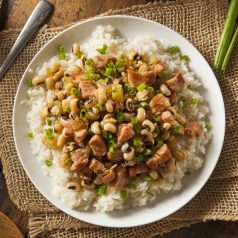
Hoppin’ John
The black-eyed pea was first introduced in the New World by Africans who carried the dried legume here with them from West Africa. The U.S. Library of Congress has records of its arrival as early as 1674. James Beard award-winning chef and cookbook author Edna Lewis, known as the First Lady of Southern Cooking, shares in her timeless cookbook In Pursuit of Flavor that in her home state of Virginia, Southern farmers planted them in abundance to supply nitrogen to the soil between cash crops. Before the plants were tilled in, farmers welcomed anyone to go out and pick the peas. Lewis remembers her family storing the dried pods in cotton sacks until “on a cold winter afternoon when there was nothing better to do, we would shell the peas.” Because of its significance in African foodways, dishes with black-eyed peas are commonly made for feast days and other special occasions among members of the African Diaspora, most notably on New Year’s Day to bring good fortune and prosperity, and during Kwanzaa, a celebration of African heritage which runs from December 26th – January 1st. Because Kwanzaa is a nod to harvest celebrations in Africa, when communities honor crops and laborers, food plays an important role — particularly soul-food staples like Hoppin’ John. You’ll find black-eyed peas and rice featured in our Weekly Sale from December 29th – January 4th, so it’s a great time to give this dish a try!

